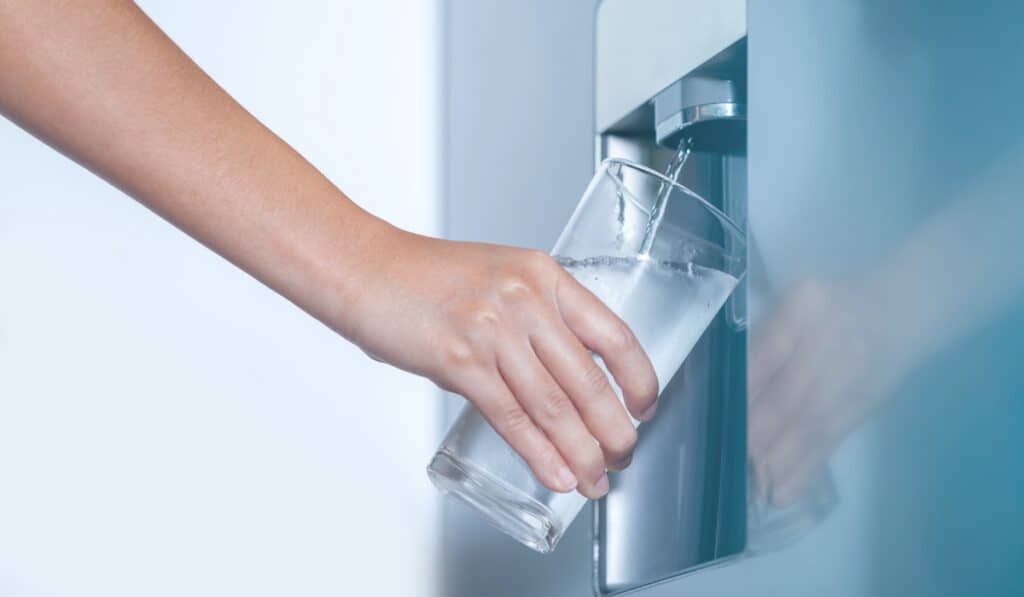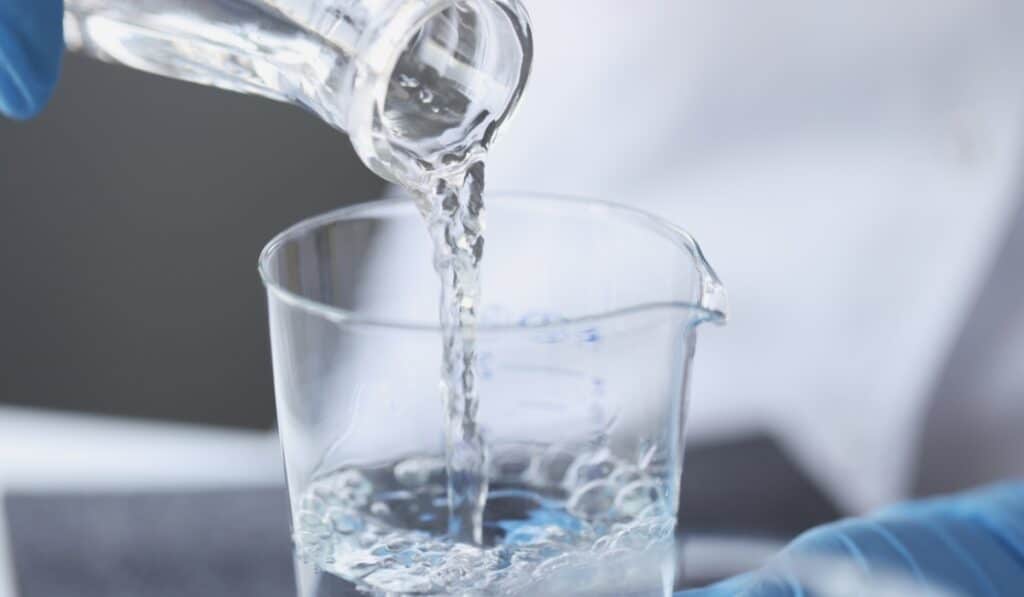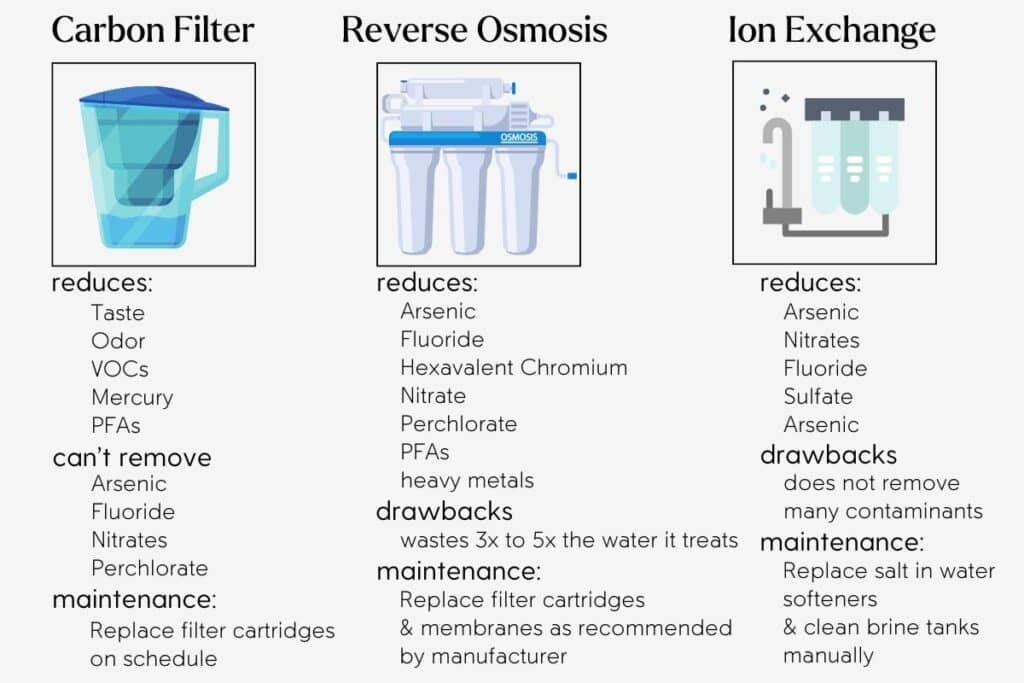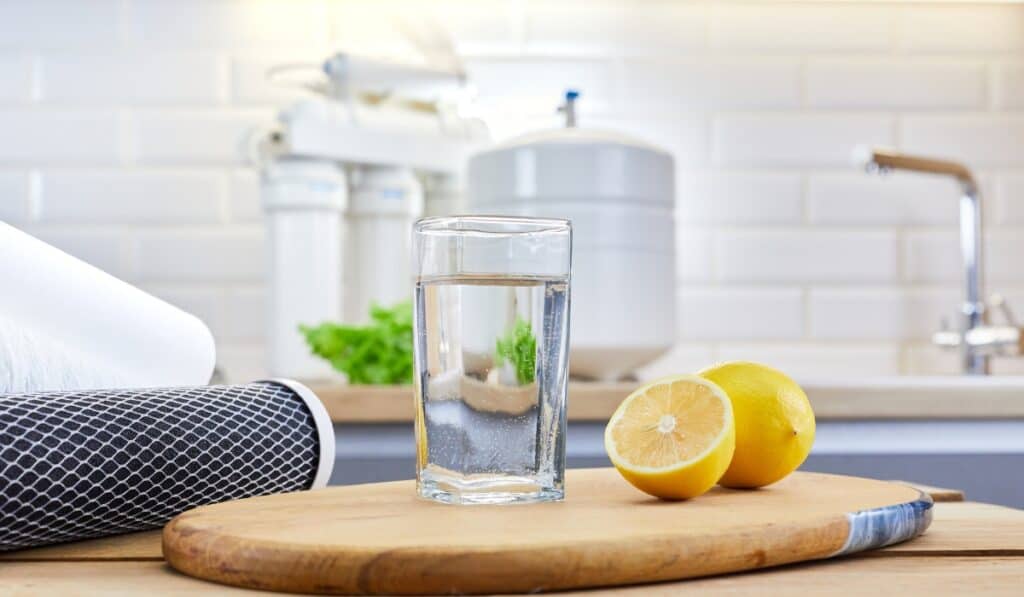How To Choose A Water Filter & The Best Water Filter For Your Home
Is your drinking water contaminated with harmful chemicals like lead, arsenic and PFAS? Test your tap water and choose the best home water filter from our guide so you don’t have to settle for contaminated water.

It wasn’t until lead contamination was discovered in the public water system in Flint, Michigan that I even gave a thought to what was in my water. I just assumed that since I didn’t live in a third world country, all was good with my tap water.
With a little research, I learned that some American cities still struggle to supply safe drinking water. As if that’s not troubling enough, a 2023 study by the US Geological Survey found that close to half of the water supply in the United States is contaminated with PFAS forever chemicals, and that 56% of people in the US drank lead-contaminated water in a 2 year period between 2018 and 2020.
When it comes to non-toxic living, drinking clean, safe water without contaminants is top priority. Because our bodies require us to drink a certain amount of water daily, we may be unknowingly exposing ourselves to contamination like heavy metals and PFAs while we sip.
According to the Environmental Working Group (EWG), the guidelines for safe drinking water set by the Environmental Protection Group (EPA) are too lenient. What this means for our tap water is that we may still be exposed to concerning levels of contaminants even though the levels are within the limits set by the EPA. In addition, the EPA does not regulate many disinfection byproducts and harmful VOCs.
Even after the water in your local water supply has been treated, there may be contamination at smaller concentrations in the water. An example of this is small concentrations of pesticides and herbicides from agricultural runoff.
Even if the water at your local water treatment plant is pristine, it still has to make its way through plumbing materials, pipes and faucets before it fills your drinking cup. If any of the plumbing materials are corroded and contain lead, this lead will end up in your drinking water.
Let’s have a closer look at some of the most common toxic chemicals in contaminated water.
Lead– Lead can be harmful to human health even at low exposures, and the EPA has set the maximum contaminant level goal for lead in drinking water at zero. Young children and fetuses in utero are particularly vulnerable, and exposure to lead in this population has caused serious health issues like lower IQ and problems with learning and behavior.
It’s extremely important to test lead levels in your water at home because plumbing materials may contain lead and contaminate the water as it flows through the plumbing system in your home.
In my city alone, I found that there are still approximately 80,000 to 90,000 lead service lines in the distribution system– yikes!
Arsenic– Arsenic is carcinogenic. Arsenic occurs naturally in rocks, and it contaminates lakes, rivers and underground water when the rocks erode and leach arsenic into the water. Industrial and agricultural waste may contain arsenic, and any discharge or runoff can contaminate the water supply.
Copper– Copper contamination in your tap water is a result of corroding faucets, pipes and any plumbing fixtures that contain copper. Too much copper in our bodies is associated with liver and kidney damage.
Chlorine– Chlorine is added to drinking water as a disinfectant. Although adding chlorine inactivates harmful microorganisms, chlorine can react with other chemicals and create disinfection byproducts that are harmful to human health.
PFAS– PFAS, short for Per- and polyfluoroalkyl substances, is a class of fluorinated chemicals that have water repellant, nonstick and stain resistant properties. They are a group of more than 5,000 human-made chemicals that contain fluorine bonded to carbon, creating a strong chemical bond that makes them hard to break down. PFAS are also known as the “forever chemical”, since they don’t break down in the environment and can remain in our bodies for many years, causing serious health issues like cancer, immune system dysfunction and thyroid disease.
Nitrate & Nitrite– Nitrate and nitrite groundwater contamination are associated with agricultural runoff. Blue baby syndrome is a serious risk for infants exposed to high levels of nitrates, as it can interfere with oxygen transport in the blood.
Microplastics– A 2017 study found that 94% of the US water system contains microplastics. Microplastics are extremely small pieces of plastic (less than 5mm). The plasticizers (such as phthalates and Bisphenols) in both plastics and microplastics are endocrine disruptors, and they can alter our body’s natural hormone production by increasing or decreasing hormone levels, by mimicking the body’s natural hormone levels and by altering the body’s natural production of hormones. Microplastics can cause oxidative stress in the human body, as well as alter our metabolism and cause reproductive toxicity and neurotoxicity.
Pharmaceuticals– Tainted human excrement, dumping prescription drugs down the toilet, use of antibiotics in livestock and pharmaceutical companies dumping byproducts and waste from production all contribute to pharmaceutical pollution of our waterways. Most water treatment plants are not equipped to remove pharmaceuticals from water.

Best At-Home Tap Water Test
The next step is to test your tap water. This allows you to get a close up look at what contaminants could potentially be affecting your family’s health. I’m using the Tap Score Water Testing Kit because this company uses 100% EPA certified labs that have high scientific standards and each tap water sample is matched to a lab that specializes in your specific drinking water contaminants and concerns.
Testing your tap water is also very helpful in choosing the type of water filter that will work best for your home. Once you get your Tap Score water test results, you’ll know exactly what contaminants are in your tap water, and you can choose a water filter accordingly.

A Few Types of Water Filters
Activated carbon filters – Activated carbon filters remove chlorine, organic contaminants, certain heavy metals, and some volatile organic compounds from drinking water. Activated carbon filters need periodic replacement since carbon adsorption capacity is reduced over time. Cons- Keep in mind that an activated carbon filter will not remove arsenic, nitrates, fluoride and perchlorates.
Reverse Osmosis Filter– Reverse osmosis filters remove a wide range of contaminants from water, and are effective at removing dissolved salts, minerals, heavy metals, and other substances that can affect the taste, appearance, and safety of drinking water. Cons- Reverse osmosis filters also remove beneficial minerals from water, so some systems incorporate a remineralization stage to improve the water’s taste and nutritional content. The reverse osmosis system uses a lot of water compared with how much actually makes it into your glass.
Ion Exchange Filter– removes certain ions (charged particles) from water and replaces them with other ions. This process is used to soften water, remove specific contaminants, and improve water quality for various applications, including residential, commercial, and industrial settings. Cons- An ion exchange filter does not remove all contaminants from water, so this is not ideal if there are numerous contaminants in your tap water.

The Best Water Filters For Your Home
I like Aquasana home water filters because the water flow is quick and efficient, they are NSF certified, and they have a variety of water filters to choose from depending on the contaminants in your water that you worry about. The Claryum® filtration system reduces 15X more contaminants than the leading pitcher filter, while retaining beneficial minerals. Aquasana carries whole house water filters, under sink water filters and countertop water filters, and the water filters remove up to 90 contaminants, including microplastics.
From a June 2023 press release:
“Aquasana‘s patented technology uses Claryum® filtration to remove up to 99.9% of 78 contaminants, including lead, the “forever chemicals” PFOA/PFOS, asbestos, microplastics, pharmaceuticals, herbicides, pesticides, mercury, chlorine, chloramines and more. This includes the company’s all new Clean Water Machine, an electric countertop system that instantly removes 15 times more contaminants than the leading pitcher filter, five times faster, at the push of a button – zero installation required. Also included is the OptimH2O® Reverse Osmosis + Claryum® system, which combines Claryum® and RO technologies to now reduce 89 contaminants with the addition of microplastics.”
Aquasana Certifications
NSF is the gold standard for lab testing of water contaminants, and I trust NSF certified water filters due to their accurate testing and high scientific standards.
Aquasana’s Claryum® filtration technology is tested and certified to NSF/ANSI Standards 42, 53 (includes P473), and 401, for the reduction of over 97% of chlorine and chloramines, 99% of microplastics and lead, and 96% of PFOA/PFOS. It’s also certified to reduce lead, asbestos, mercury, chlorine-resistant cysts, herbicides, pesticides, VOCs, pharmaceuticals, and more.
Beneficial Minerals In Water
For proper functioning, our bodies need a trace amount of beneficial minerals, including magnesium, selenium, calcium, and sodium. Most water filtration systems that use reverse osmosis remove all beneficial trace minerals from the water, and that affects not only the taste of the water, but also the important minerals that our bodies need.
Claryum®’s selective filtration technology retains naturally occurring beneficial minerals found in water like calcium, potassium, and magnesium for healthier, more delicious water.
Here’s How the 3 Step Filter Works
Step 1: Pre-Filter improves effectiveness and extends the life of your system. 20 micron Pre-Filter captures rust, sediment, and silt that can clog your system.
Step 2: Claryum Filter: Remove the bad and retain the good with Claryum® filtration technology. Activated carbon removes microplastics, pharmaceuticals, herbicides, pesticides, PFOA/PFOS, VOCs, and more. Selective filtration retains healthy minerals like calcium, magnesium, and potassium.
Step 3: Claryum Filter: Dual Claryum® filter blocks ensure maximum contaminant removal. Catalytic carbon filters chlorine and chloramines. Ion-exchange and sub-micron filtration tackle lead, mercury, asbestos, and cysts.
The Water Filter We Have
For our home, an under-the-sink was the best option for us. It’s nice to know that whenever we turn on the tap in the kitchen, clean, uncontaminated water flows out. The model below is exactly what we have in our kitchen. We love how relatively easy it was to install and how fast the water flows out of the tap. Plus, the water tastes great and we can have peace of mind knowing that harmful chemicals aren’t in our drinking water.
Aquasana Claryum 3-Stage Max Flow Under Sink Reverse Osmosis Water Filter– Aquasana under-the-sink water filter system requires a little effort upfront to install, but once it’s set up, you’ll get filtered water for up to six months just by turning on the tap. It filters out chlorine, heavy metals, cysts, herbicides, pesticides, VOCs and more.
- Cost: $449
- Filter Type: Reverse Osmosis
- Operating Pressure: 20-80 psi
- Operating Temperature: 40-90°F
- Rated Service Flow: 0.72 gpm
- Maximum Capacity: 800 gallons
- System Dimensions: 4.25″ x 12″ x 12.85″ (L x W x H)
- Shop: Aquasana Claryum 3-Stage Max Flow Under Sink Reverse Osmosis Water Filter
Whole House Water Filter
Aquasana Whole House Water Filters include whole house filters for well water and city water. If you’re on well water, choose the Aquasana Whole House Rhino Well Water Filter with UV to protect from bacteria, viruses, cysts and other contaminants commonly found in well water.
Aquasana Rhino Max Whole House Water Filter System is comprised of carefully sequenced stages, each with its own unique formula of high-potency, contaminant-grabbing media and filtration. This filter is independently tested and features a smart design, low maintenance, easy to replace filters, boosted water flow, bacteriostatic media and strong and safe materials.
Please see Aquasana website for dimensions and specifications of all whole house water filters.
Countertop Water Filter
The Aquasana Clean Water Machine delivers a cup of clean drinking water in 8 seconds. The Aquasana Clean Water Machine reduces over 99% of microplastics, lead and cysts; 97% of chlorine and chloramines; 96% of mercury; and 95% of PFOA/PFOS and VOCs. This countertop system is also tested and certified to reduce asbestos, herbicides, pesticides, pharmaceuticals, and more. In all, it tackles 15X more contaminants than the leading pitcher filter. Claryum® selective filtration technology helps retain naturally occurring beneficial minerals found in water like calcium, potassium, and magnesium for healthier, more delicious water. The Clean Water Machine is made of sturdy, food-grade plastic that is 100% free of BPA.
- Cost: $399
- Filter Type: Activated Carbon, catalytic carbon and ion echange
- Operating Pressure: 20-70 psi
- Operating Temperature: 40-90°F
- Maximum Capacity: 300 gallons
- Water Tank Capacity: 64 ounces
- System Dimensions: 9.69″ x 7.96″ x 11.61″ (L x W x H)
- Shop: Aquasana Clean Water Machine
Replacement Filters
It’s important to replace filter cartridges and membranes as recommended by the manufacturer. If you’re using an ion exchange system, you will need to replace the salt in water softeners and clean the brine tanks manually.
Aquasana Replacement Filters– Aquasana offers single replacement filters as well as multiple replacement filters, and they also offer a discounted subscription service so you’ll never have to worry about reordering.
Disclosure: This post contains affiliate links, which means if you make a purchase through these links, we may receive a small commission at no extra cost to you.


